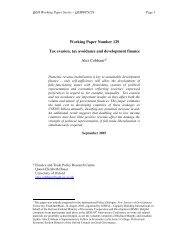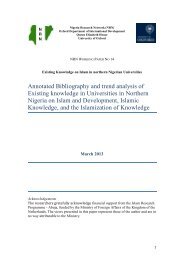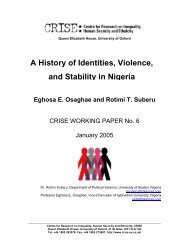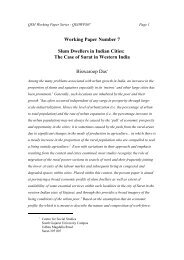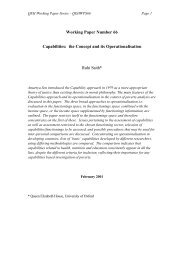Acute Multidimensional Poverty: A New Index for Developing ... - OPHI
Acute Multidimensional Poverty: A New Index for Developing ... - OPHI
Acute Multidimensional Poverty: A New Index for Developing ... - OPHI
You also want an ePaper? Increase the reach of your titles
YUMPU automatically turns print PDFs into web optimized ePapers that Google loves.
<strong>Acute</strong> <strong>Multidimensional</strong> <strong>Poverty</strong>: A <strong>New</strong> <strong>Index</strong> <strong>for</strong> <strong>Developing</strong> CountriesAlkire & SantosThe potential dimensions that a measure of poverty might reflect are quite broad and include health,education, standard of living, empowerment, work, environment, safety from violence, socialrelationships, and culture among others. In the context of choosing capabilities that have a moralweight akin to human rights, Sen has suggested focusing on dimensions that are of a) specialimportance to the society or people in question, and b) social influenceable – which means that they arean appropriate focus <strong>for</strong> public policy, rather than a private good or a capability like serenity whichcannot be influenced from outside. 13In practice, the selection of the 2010 HDR dimensions has relied on the following mechanisms:a. The first is the literature arising from participatory exercises, which engage a representativegroup of participants as reflective agents in making the value judgments to select focalcapabilities. All of the dimensions <strong>for</strong> the MPI have been regularly identified as importantelements of ill-being by communities.b. The second is the use of some enduring consensus, particularly surrounding human rights andthe Millennium Development Goals (MDGs).c. The third is theory based, as in the many philosophical or psychological accounts of basicneeds, universal values, human rights, and so on.d. The fourth and the binding constraint is whether the data exist. Due to data constraints (as wellas, perhaps, interpretability) we have had to severely limit the dimensions. For example, wedo not have sufficient data on work or on empowerment. Yet each of these dimensionsshould arguably be considered in a human development-based multidimensional povertymeasure. 14The MPI includes three dimensions: health, education, and the standard of living. The dimensionsmirror the HDI. Why is this? Now, as then, data <strong>for</strong>m the binding constraint. The construction ofthe HDI was driven to a great extent by the cross-country data available in 1990, as well as the needto generate a simple compelling policy message. It included three dimensions and four indicators.The Human <strong>Poverty</strong> <strong>Index</strong> (HPI) released in 1997 maintained the same three dimensions, butdefined the indicators differently. Both the HDI and the HPI have been criticized <strong>for</strong> not includingadditional dimensions, such as those identified as human rights or within the MDGs. We very muchwished the MPI to include additional vital dimensions. Un<strong>for</strong>tunately, we can state categorically thatcomparable data of sufficient quality are not available from the same survey in the public domain <strong>for</strong>100+ less developed countries to consider any other dimensions, nor to include consumption data. 15However there are several arguments in favor of the chosen dimensions. First, parsimony: havingonly three dimensions simplifies comparisons with income poverty measures. Second, consensus:while there could be some disagreement about the appropriateness of including work,empowerment, or physical safety in a poverty measure, the value of health, education, and basicstandard of living variables is widely recognized. Third, interpretability: there are substantialliteratures and fields of expertise on each of these topics, which will make analysis of the MPI easier.Fourth, data: while some data are poor, the validity, strengths, and limitations of various indicatorsare well documented; such documentation is not as developed in domains such as empowerment.Fifth, inclusivity: human development appreciates both the intrinsic and the instrumental value ofthese dimensions. These same dimensions are emphasized in human capital approaches that seek to13 Sen 2004b.14 Alkire 2008.15 Additional questions are available in the Gallup International survey but the data are not publicly available.www.ophi.org.uk July 2010 12



